Chapter 16
Malta
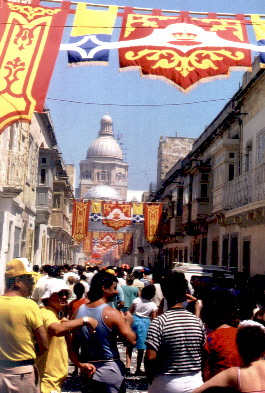 A
mere dot on the map of Europe, Malta has more to offer than might initially
be suspected. Its vast natural harbor has made it of interest to any settler
who may come by - and they have been coming since the Stone Age. Phoenicians,
Romans, Arabs, Knights of St. John, Napoleon and the British have all made
their mark on the island and the present day Maltese speak a language that
is mainly of Semitic origin but contains many borrowings from other languages.
Due to the very recent influence of the British, English is spoken everywhere.
Both Maltese and English are official languages.
A
mere dot on the map of Europe, Malta has more to offer than might initially
be suspected. Its vast natural harbor has made it of interest to any settler
who may come by - and they have been coming since the Stone Age. Phoenicians,
Romans, Arabs, Knights of St. John, Napoleon and the British have all made
their mark on the island and the present day Maltese speak a language that
is mainly of Semitic origin but contains many borrowings from other languages.
Due to the very recent influence of the British, English is spoken everywhere.
Both Maltese and English are official languages.
On your first trip ashore you may be disappointed to see street decorations
being taken down. Statues of saints and angels are dismantled and lights
and banners stored away. Obviously some religious festival that is just
over. Do not despair, just around the corner street decorations are being
put up! Festivities go on the whole summer, each parish celebrating its
saint for at least 3 days. There is not a weekend in Malta without at least
one festival complete with procession and fireworks going on somewhere.
The Maltese love celebrating and everybody can take part.
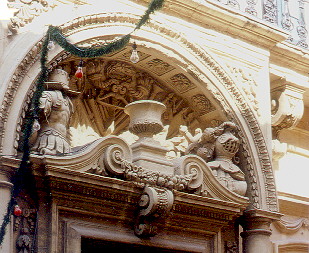 During
the week you can take a look at the historical sights. Malta was very badly
damaged during the Second World War. It was bombed so heavily that Valetta
was 95% destroyed. In fact the islanders as a whole were awarded the George
Medal for Civil Bravery. There are no signs of this devastation today.
La Valetta is a beautiful town, built of the yellow limestone quarried
nearby, that gives the buildings a warm color. The town goes back to John
la Valette who was the Grand Master of the Knights of St. John when they
came to Malta from Rhodes in 1565. It was his concept to build the town
in straight parallel roads, that go up and down over the rocky peninsula.
As you approach Valetta from the sea it is a splendid sight. Fortresses
protect each of the branches of the harbor, and domes and church towers
rise above the yellow stone buildings.
During
the week you can take a look at the historical sights. Malta was very badly
damaged during the Second World War. It was bombed so heavily that Valetta
was 95% destroyed. In fact the islanders as a whole were awarded the George
Medal for Civil Bravery. There are no signs of this devastation today.
La Valetta is a beautiful town, built of the yellow limestone quarried
nearby, that gives the buildings a warm color. The town goes back to John
la Valette who was the Grand Master of the Knights of St. John when they
came to Malta from Rhodes in 1565. It was his concept to build the town
in straight parallel roads, that go up and down over the rocky peninsula.
As you approach Valetta from the sea it is a splendid sight. Fortresses
protect each of the branches of the harbor, and domes and church towers
rise above the yellow stone buildings.
The Knights of St. John initially had their headquarters in Akko in
present day Israel. They were forced to leave there at the end of the 13th
century and after a brief period on Cyprus set up home on Rhodes. Fleeing
before the Turks they came to Malta in 1524 and were given the island by
the emperor Charles V in 1530. They were forced to defend Malta before
they had even become properly established. This time they were able to
maintain their position and shortly after they sailed to join the European
allied forces against the Turks at the Battle of Lepanto in 1571. This
victory secured them the popularity of the remaining European nations and
the riches that were invested in the building of La Valetta. The knights
lived in national groups and the mansions built for each group now house
various government departments.
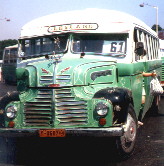 |
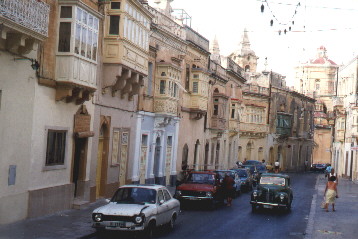 |
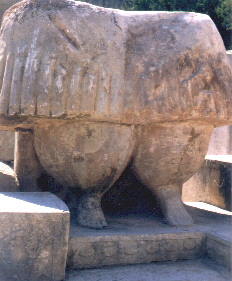 |
| Public transport on the island is by bus. The friendly
climate of the islands has preserved many an old car and bus, and in 1989
the oldest bus still in service dated from 1940. Each driverís cab has
a little madonna or saint behind glass in one corner. There are regular
bus services to the other towns and so it is possible to visit the old
walled town of Mdina that once was the capital of Malta or the various
Stone Age temples that are older than Stonehenge. |
|
|
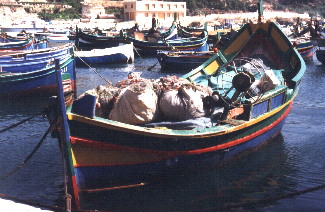 Malta
is not just one island. Comino and Gozo are also worth a visit. Comino
has a nice anchorage for snorkeling and swimming in clear water: a pleasant
place to relax from sightseeing. Gozo has some surprises in store. Here
is the largest Stone Age temple Ggantija that is thought to date back to
3500 - 4000 BC. In Mgarr, where the harbor is, there is a magnificent Gothic
cathedral. However it does not date from Gothic times but has been built
in phases in this century and is not finally finished yet! It is a masterpiece
of stonemasonry and will be splendid, and yet it is far too large for the
parish it serves. In the harbor at Gozo you can take a close look at the
Maltese fishing boats. Brilliantly colored, these boats have the name "Luzzo"
which means light.
Malta
is not just one island. Comino and Gozo are also worth a visit. Comino
has a nice anchorage for snorkeling and swimming in clear water: a pleasant
place to relax from sightseeing. Gozo has some surprises in store. Here
is the largest Stone Age temple Ggantija that is thought to date back to
3500 - 4000 BC. In Mgarr, where the harbor is, there is a magnificent Gothic
cathedral. However it does not date from Gothic times but has been built
in phases in this century and is not finally finished yet! It is a masterpiece
of stonemasonry and will be splendid, and yet it is far too large for the
parish it serves. In the harbor at Gozo you can take a close look at the
Maltese fishing boats. Brilliantly colored, these boats have the name "Luzzo"
which means light.
The locals claim that Gozo is the island of Ogygia where Odysseus met
the nymph Calypso. Who knows? He stayed seven years and certainly 2 weeks
are not enough to appreciate all that the islands of Malta have to offer.
© Dianne Reichart
1997
List of contents
 A
mere dot on the map of Europe, Malta has more to offer than might initially
be suspected. Its vast natural harbor has made it of interest to any settler
who may come by - and they have been coming since the Stone Age. Phoenicians,
Romans, Arabs, Knights of St. John, Napoleon and the British have all made
their mark on the island and the present day Maltese speak a language that
is mainly of Semitic origin but contains many borrowings from other languages.
Due to the very recent influence of the British, English is spoken everywhere.
Both Maltese and English are official languages.
A
mere dot on the map of Europe, Malta has more to offer than might initially
be suspected. Its vast natural harbor has made it of interest to any settler
who may come by - and they have been coming since the Stone Age. Phoenicians,
Romans, Arabs, Knights of St. John, Napoleon and the British have all made
their mark on the island and the present day Maltese speak a language that
is mainly of Semitic origin but contains many borrowings from other languages.
Due to the very recent influence of the British, English is spoken everywhere.
Both Maltese and English are official languages.
 During
the week you can take a look at the historical sights. Malta was very badly
damaged during the Second World War. It was bombed so heavily that Valetta
was 95% destroyed. In fact the islanders as a whole were awarded the George
Medal for Civil Bravery. There are no signs of this devastation today.
La Valetta is a beautiful town, built of the yellow limestone quarried
nearby, that gives the buildings a warm color. The town goes back to John
la Valette who was the Grand Master of the Knights of St. John when they
came to Malta from Rhodes in 1565. It was his concept to build the town
in straight parallel roads, that go up and down over the rocky peninsula.
As you approach Valetta from the sea it is a splendid sight. Fortresses
protect each of the branches of the harbor, and domes and church towers
rise above the yellow stone buildings.
During
the week you can take a look at the historical sights. Malta was very badly
damaged during the Second World War. It was bombed so heavily that Valetta
was 95% destroyed. In fact the islanders as a whole were awarded the George
Medal for Civil Bravery. There are no signs of this devastation today.
La Valetta is a beautiful town, built of the yellow limestone quarried
nearby, that gives the buildings a warm color. The town goes back to John
la Valette who was the Grand Master of the Knights of St. John when they
came to Malta from Rhodes in 1565. It was his concept to build the town
in straight parallel roads, that go up and down over the rocky peninsula.
As you approach Valetta from the sea it is a splendid sight. Fortresses
protect each of the branches of the harbor, and domes and church towers
rise above the yellow stone buildings.



 Malta
is not just one island. Comino and Gozo are also worth a visit. Comino
has a nice anchorage for snorkeling and swimming in clear water: a pleasant
place to relax from sightseeing. Gozo has some surprises in store. Here
is the largest Stone Age temple Ggantija that is thought to date back to
3500 - 4000 BC. In Mgarr, where the harbor is, there is a magnificent Gothic
cathedral. However it does not date from Gothic times but has been built
in phases in this century and is not finally finished yet! It is a masterpiece
of stonemasonry and will be splendid, and yet it is far too large for the
parish it serves. In the harbor at Gozo you can take a close look at the
Maltese fishing boats. Brilliantly colored, these boats have the name "Luzzo"
which means light.
Malta
is not just one island. Comino and Gozo are also worth a visit. Comino
has a nice anchorage for snorkeling and swimming in clear water: a pleasant
place to relax from sightseeing. Gozo has some surprises in store. Here
is the largest Stone Age temple Ggantija that is thought to date back to
3500 - 4000 BC. In Mgarr, where the harbor is, there is a magnificent Gothic
cathedral. However it does not date from Gothic times but has been built
in phases in this century and is not finally finished yet! It is a masterpiece
of stonemasonry and will be splendid, and yet it is far too large for the
parish it serves. In the harbor at Gozo you can take a close look at the
Maltese fishing boats. Brilliantly colored, these boats have the name "Luzzo"
which means light.